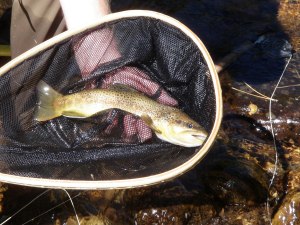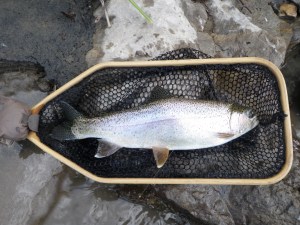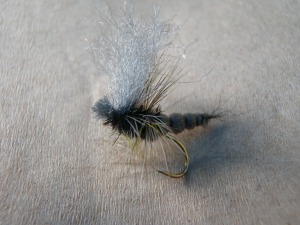Time: 12:00PM – 5:30PM
Location: Canyon area accessed by Bright Trail
Fish Landed: Dave – 18, Dan 14
North Fork of St. Vrain 09/19/2010 Photo Album
Dan and I planned a hike and fish day a while ago into the North Fork of the St. Vrain. On Sunday September 19 we executed the plan. I had done this hike by myself in September of 2007, but I drove the minivan and, therefore had to park at the beginning of the national forest four wheel drive road and hike a couple miles on the road before reaching the trailhead. The hike out of the canyon in this area is extremely taxing with a steep ascent of a south facing slope.
For our latest adventure, I took the RAV4 so we could drive to the trailhead, and we planned to begin hiking out around 6PM when the sun was lower in the sky. We left Stapleton at around 8:20AM and drove through Lyons then passed Allenspark and turned right on road 84 at Meeker Park. This road twisted around until we reached the Y where the rough forest road would take us to the trailhead. Jane and I had removed all the windows on the RAV for summer, and Jane zipped the side windows back in but left the rear window open. We soon discovered that the national forest road had been graded recently, and that combined with the dry September weather left an inch or so of fine dirt on the surface. As we drove the rough road, the dust began pouring in the rear window and piling up on us and the steering wheel and windshield and every square inch of internal surface area. We created our own depression era dust bowl within the RAV.
In spite of inhaling copious amounts of dust, we managed to arrive at the trailhead. We gathered all our necessary fishing gear along with lunch and raincoats and began the hike down to the stream. The first mile or so is a nice trail through a rolling forested section. The last mile is a steep descent with sliding stones and brittle dry vegetation that grabs your socks and pants. The trail becomes extremely faint near the bottom, so we more or less just cut across the prairie grass to reach the stream. We found a spot to unpack our fishing gear and ate our lunches at around 11:30AM.
Dan and decided to cross the stream and hike down the path on the south side and explore that area. On my previous trip, I’d hiked down the north side, but reached a place where the canyon narrowed, and it was difficult to progress further. There was a decent path on the south side that we followed beyond a spot where the stream divided and both channels were low and difficult to fish. Even below the island the stream was low due to September conditions, so we opted to alternate pools. There was a juicy spot directly across from us, so I volunteered to start a bit below that in some shallower riffles that didn’t appear to be as attractive.
We both tied on Chernobyl ants and trailing beadhead hares ears. I discovered that I’ve used up all the beadhead hares ear nymphs that I tied in the off season. I flicked the Chernobyl and hares ear in some marginal water and hooked and landed a small brown on the first cast on the BHHE. I landed two more browns from the same shallow riffles and then turned the juicy pool over to Dan. I think Dan pulled a small brown from the nice pool, and then we moved on upstream. We continued fishing this way alternating for the next two or three hours.
We set up some friendly competition and began counting landed fish. Dan was doing quite well as I watched him place his casts and cover the best lies and water. I landed a brown that was around 12-13 inches and speculated that would be my largest fish, so Dan photographed the fish and then took a second photo of me holding the fish. It wasn’t too long after that when Dan hooked and landed a fish of comparable size so I returned the favor and photographed his fish and then a fisherman/fish photo. We had each caught around 12 fish when things began to slow down. This was probably around 3PM. I later discovered that Denver set a new high with temperatures reaching 96 degrees on September 19, so it is understandable that the fishing turned off in the mid-afternoon sun.
I switched to a parachute hopper with a gray body and left off the dropper and managed to pick up six more fish over the remaining two hours, but the catch rate declined considerably. After I had some success, I tied on a parachute hopper for Dan. The shadows began covering the south side of the stream, so the white wing on the parachute hopper proved to be a major aid in following the fly. Dan was fishing along the north side so he was able to see the Chernobyl longer before moving to the parahopper. By 5:30 I’d landed 18 and Dan had netted 14, and we were feeling rather lethargic due to the heat. We had fished upstream beyond the point where we stashed our gear and could smell a campfire, so we stepped up the bank and discovered three guys from Littleton at a nice campsite on the south side. They were sharing some Jim Beam and enjoying their hard earned fire after gathering firewood.
The shadow was now roughly half way up the steep north slope, and the air had cooled a bit, so we changed back into our hiking clothes, stashed our fishing gear in our backpacks, ate some snack bars, and took some deep breaths and began the climb. I don’t know if it was because I had a companion, or because we waited until the sun dropped, but the climb didn’t seem nearly as difficult as the previous venture. We stopped to rest and catch our breath 6-10 times (Dave was the catalyst for most of the rest stops), and reached the top of the canyon in 45 minutes. The south facing slope was totally covered in shadows by the time we reached the top, and darkness was descending quickly as I switched out my sunglasses for normal lenses.
When we got back to the RAV, we zippered the back window into place as best we could in spite of the thick layers of dust everywhere. We negotiated the four-wheel drive dusty road in the dark, and stopped to celebrate our day and eat dinner at the Oskar Blues beer pub in Lyons.
































































